Buddhist Mountain Monasteries in Korea
Seonamsa Temple
Seonamsa Temple
Introduction
Natural Environment
History
Temple Layout
Cultural Properties
Information
About Seonamsa Temple
-
-
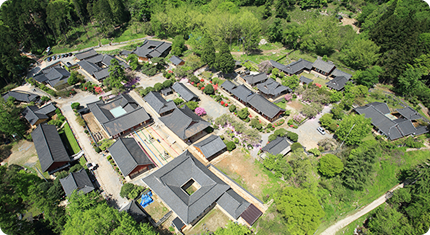 View of Seonamsa Temple
View of Seonamsa Temple
-
Situated in Suncheon-si, Jeollanam-do Province, Seonamsa Temple is seated on the foothills of Jogyesan Mountain, one of the most scenic mountains in the Honam region of Korea.
Jogyesan is actually the name of a geographical feature in China, but according to Songgwangsaji, “King Huijong of Goryeo in 1209 was overjoyed to hear the news of National Preceptor Bojo, whom he had admired from a young age, founding Suseonsa Shrine at the former site of Gilsangsa and initiating the Jeonghyegyeolsa Movement. He bestowed a tablet that read, ‘Jogyesan Suseonsa,’ and greatly praised the monk. Since then, the mountain has been called Jogyesan.” The name of the temple, Seonamsa, was given because of a flat rock found west of the temple where a Taoist monk used to play baduk (Go).
-
-
Jukhak-ri, Seungju-eup, Suncheon-si, Jeollanam-do Province. It consists of approximately 20 buildings and 4 affiliated temples (amja). It is said that the Great Monk Ado started the temple in 527. It is known to have been reestablished in the 9th century by the National Preceptor Doseon. As the headquarters of the Taego Order of Korean Buddhism, the buildings are quite large and the temple is characterized by its multi-layered square planned buildings with inner courtyards. As the temple was established over the period of 200 years, the layout takes on the form similar to that of a rural village.
There are two theories regarding the founding of Seonamsa Temple. One theory suggests that Monk Ado Hwasang founded the temple in 529 (3rd year of reign of King Jinheung of Silla) as a Bibo temple and called it Haecheonsa of Cheongnyangsan Mountain, while the other suggests that it was founded as a protected temple by National Preceptor Doseon in 875 (1st year of King Heongang’s reign) and called Seonamsa. - It was rebuilt into a massive temple by National Preceptor Daegak in the Goryeo Dynasty. Then, later, it was destroyed several times due to war and especially by fire.
For this reason, the names of the mountain and the temple were changed to Cheongnyangsan and Haecheonsa, respectively, in 1759 (35th year of King Yeongjo’s reign) as a measure to prevent fire.
These names can still be observed on the tablet behind the Iljumun (One Pillar) Gate at present, and there are also engravings of the Sino-Korean characters meaning “water” and “sea/ocean.”
Because numerous monks invested great efforts to rebuild and restore the temple every time it was damaged and destroyed, Seonamsa has been able to maintain its present size.
-
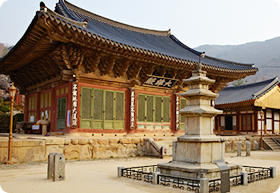 Main Hall of Seonamsa Temple
Main Hall of Seonamsa Temple
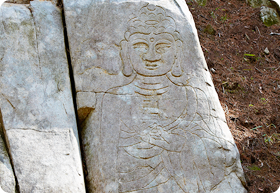 Rock Carved Standing Buddha of Seonamsa Temple
Rock Carved Standing Buddha of Seonamsa Temple
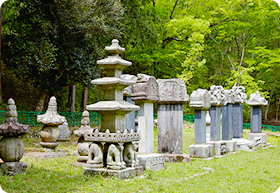 Stupas of Seonamsa Temple
Stupas of Seonamsa Temple
-
- At Seonamsa Temple, a tranquil and serene place of meditation, three things are absent. First, the Gates of the Four Devas (the heavenly guardians of Buddhism) are absent. It’s bee said that because the main peak of Jogyesan Mountain is Janggunbong Peak (lit. meaning “General” or “Admiral”), they believed that they were safeguarded by generals, and this is why they did not create any statues of the Four Devas. Second, there aren’t any sculptures of attendant bodhisattvas in the main hall. The mudra of the statue of Sakyamuni in the main hall is the “Surrender to Mara and touching the earth mudra” and because it represents the moment of surrender to Mara (the devil or evil one), a sculpture of an attendant bodhisattva was not placed there. Third, the main hall does not have an eoganmun, which is a central door through which only the enlightened can pass. Thus, because it cannot be used by the lay people, they decided not to install an eoganmun at Seonamsa Temple.
-
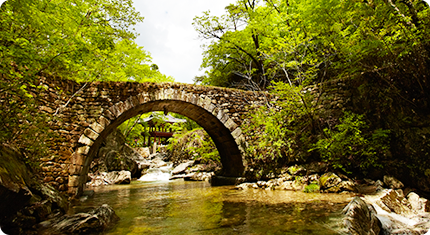 Seongseongyo Bridge of Seonamsa Temple
Seongseongyo Bridge of Seonamsa Temple
- Seonamsa Temple is also famous for its exquisite cultural properties including Seonammae (Natural Monument No. 488), which blooms every spring, and Seungseongyo Bridge (Treasure No. 400) at the temple entrance. Seonamsa Temple has been designated Historic Site No. 507, while the Songgwangsa and Seonamsa temples of Jogyeosan Mountain have been designated as Scenic Site No. 65. There are four hermitages on the mountain including Daegagam, Unsuam, Daeseungam and Biroam.
